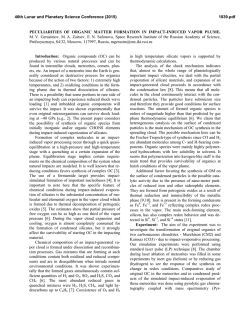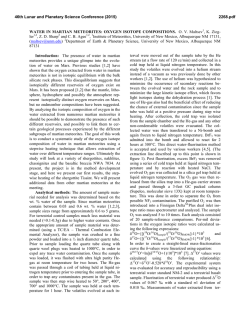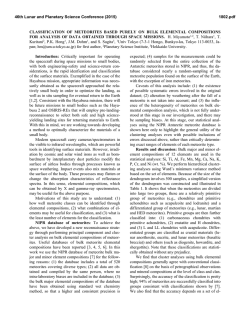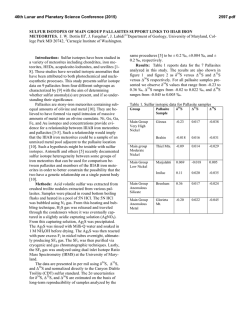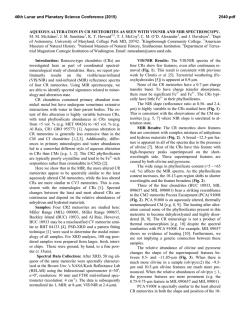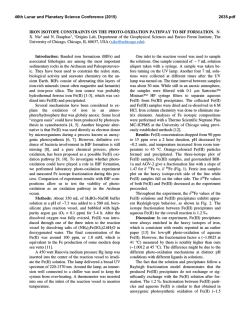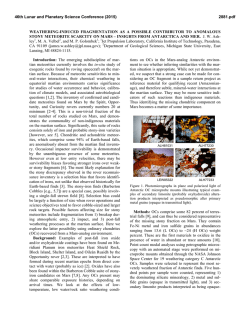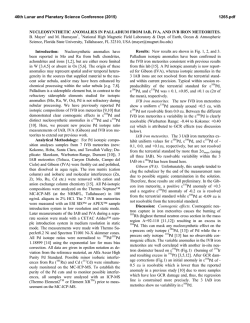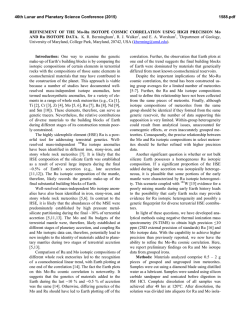
TOWARDS MERCURY (Hg) COSMOCHEMISTRY: VARIABLE
46th Lunar and Planetary Science Conference (2015) 1101.pdf TOWARDS MERCURY (Hg) COSMOCHEMISTRY: VARIABLE CONTRIBUTIONS OF SUPERNOVADERIVED Hg, OR MASS-INDEPENDENT FRACTIONATION BY PHOTODEGRADATION? M. M. M. Meier1, C. Cloquet1 and B. Marty1, 1Centre de Recherches Pétrographiques et Géochimiques, CNRS Université de Lorraine, 15 Rue Notre Dame des Pauvres, 54500 Vandœuvre-lès-Nancy, France ([email protected]). Introduction: Mercury (Hg) is the heaviest element with seven stable isotopes, spanning a 4% range in relative mass. Five isotopes (199-202Hg, 204Hg) are produced by both the r- and s-process, while 198Hg is produced by the p- and s-process. The least abundant isotope 196Hg is produced exclusively in the p-process [1][2]. Observations of the λ3984 Hg-II-line in the spectrum of some peculiar A- and B-type stars (“Hg-stars”) suggests strong variations in the abundance of 204Hg, to the point where it is the most abundant isotope, perhaps due to extreme mass-dependent fractionation in stellar atmospheres [3]. The high volatility of Hg makes this element a potential tracer for processes during solar system formation, e.g. condensation in the nebula, parent-body heating, volatile loss during giant impacts, and late delivery of volatiles to planets. Both mass-dependent (MDF) and mass-independent (MIF) fractionations have been observed in terrestrial environments, allowing to identify sources contributing to a given Hg inventory [4][5]. Given this potential, surprisingly little is known about Hg in meteorites. Most classes have been analyzed by Neutron Activation Analysis (NAA), which is only sensitive to the abundance of 202Hg and to the 196 Hg/202Hg ratio (see compilation by [6]). Large variations in these two values found by most authors have been shown by [6] to be mostly due to interferences on 202 Hg. A study of Hg isotopic composition in the meteorites Allende (CV3) and Murchison (CM2) by ICPMS [7] revealed no deviation from the terrestrial composition within error (~0.2-1.0‰, depending on the isotope), except for a slight 200Hg deficit in Allende. These authors also give ICP-MS-based concentrations for these two meteorites, of ca. 30 and 300 ppb, respectively, the latter in accordance with solar estimates [2][8]. By exposing meteorite samples to a saturated Hg atmosphere, [7] demonstrated that contrary to initially held fears, contamination of meteorite samples by terrestrial Hg is unproblematic. Samples and Methods: With a few exceptions, we used quickly recovered meteorites from large falls. All meteorites measured so far for their Hg concentration (and, in some cases, for their isotopic composition) are listed in Table 1. Concentrations were measured using a Milestone SRL Direct Mercury Analyzer (DMA-80) at SARM CNRS Nancy, with an effective sensitivity down to ~1 ng Hg. This instrument has shown excellent accuracy and precision for Hg concentrations in environmental sciences [9]. Prior to measurement, the sam- ples were powdered (to ~10 μm size). In each DMA run, aliquots of the powder with masses between a few and a few 100 mg were consumed. Table 1: Samples and Hg concentrations Meteorite Bencubbin class CBa Source WAM ppb ±1 SD n 217 ±135 2 Orgueil CI1 MNHN 13600 ±5200 4 Karoonda CK4 SAM 401 ±73 2 Murchison CM2 CRPG 2570 ±50 2 Paris CM2.7 MNHN 11800 ±2500 2 Kainsaz CO3.2 ASM 267 ±29 2 Allende CV3 CRPG 39 ±13 2 NWA 7323 LL3 CRPG 19 ±6 2 Mezö-Madaras L3.7 VNHM 3150 ±520 2 Saratov L4 CRPG 18 ±1 2 Ghubara L4-6 LU 44 - 1 Mocs L5/6 VNHM Millbillillie Eurcrite WAM Norton County - breccia - dark phase - enstatite cryst. Aubrite Terrestrial MORB glasses 965 ±140 2 28 ±2 2 94 ±1 627 ±20 15 ±9 2 2 2 <5 to 255 - UNM CRPG For the MC-ICP-MS analysis (on a Thermo Neptune+ at CRPG CNRS Nancy), powder aliquots up to a few grams in mass were exposed to 7 ml concentrated (>65%) HNO3 for two hours at 200 bars in a High Pressure Asher (HPA). The resulting solution was centrifuged to remove particulates and reacted with SnCl2 to produce gaseous Hg(0), which was then brought directly into the mass spectrometer by an Ar carrier[4]. Results & Discussion: Concentrations vary from <10 ppb to 14'000 ppb for different meteorites, similar to what was historically observed using NAA. There is no systematic variation with class or petrologic type: Orgueil is strongly aqueously altered, but it shares very high Hg concentrations with the nearly “pristine” Paris CM2.7 chondrite [10]. Such high concentrations for Orgueil have been found before, but were dismissed by [2] as terrestrial contamination. Given the isotopic anomalies observed in Orgueil, Paris, Murchison and other meteorites (see below), this seems an unlikely explanation. It should also be noted that the Hg concentration for Orgueil is significantly different (higher) from the solar abundance [8], in stark contrast to most other elements. The Hg concentration we find for 46th Lunar and Planetary Science Conference (2015) Figure 1: Hg abundance vs. MDF. The shown Rayleigh fractionation line starts at δ202Hg = -4 and 15'000 ppb. Murchison is a factor of 10 higher than found by [7], although for Allende it is similar. For a sample that has been thermally altered, the Hg concentration in Mocs (L5/6) is surprisingly high. As shown in Fig. 1, a Rayleigh fractionation cannot produce the observed variation in concentration and mass-dependent fractionation (MDF). There is a clear correlation between the mass-independent fractionation (MIF) of the odd-numbered Hg isotopes (Δ199Hg, Δ201Hg), as shown in Fig. 2 (note that this correlation could not have been observed by [7] (grey symbols) due to the higher uncertainties of their analysis). When the data are normalized to the 202 Hg/198Hg ratio (solid symbols), they plot along a line having a slope of 1.35±0.13, in very good agreement with the MIF observed in photo-degraded Methyl-Hg 1101.pdf in terrestrial samples. However, based on thermal release profiles, Hg in meteorites is probably bound in HgS [7]. Furthermore, normalization to the 200Hg/198Hg ratio (open symbols) yields a significantly (~1.5σ) higher slope of 1.71±0.25, which is not expected if the MIF were due to photodegradation. A possible alternative interpretation of this pattern is the addition of rprocess (supernova) material. The two trends extrapolate (Fig. 3) to supernova-produced Hg [11]. The different slopes for the 202Hg/198Hg vs. 200Hg/198Hg normalizations are predicted by the SN-addition model (closed vs. open star symbols in Fig. 3). A contribution of ca. 0.05% SN-derived Hg would be enough to change an Orgueil-like Hg-isotopic composition to an Earth-like composition. Such a contribution however also predicts a large effect on the p-process isotope 196Hg, on the order of a depletion of 5-20‰ (depending on the SNmodel) in Orgueil relative to Earth. Follow-up analyses of Hg in meteorites, this time including 196Hg, are in preparation and will be presented at the meeting. Figure 3: Similar to Fig. 2, but including SN models by [11] Figure 2: MIF on odd-numbered Hg isotopes. References: [1] Jaschek C. and Jaschek M. (1995), The Behavior of Chemical Elements in Stars, Cambridge University Press. [2] Palme H. and Beer H. (1993), Landolt-Börnstein New Series IV/3a, Springer Verlag. [3] White R. E. et al. (1976), APJ 204, 131140. [4] Estrade N. et al. (2011), Env. Sci. & Techn. 45, 1235-1242. [5] Blum J. (2014), AREPS 42, 249– 69. [6] Lauretta D. S. et al. (1999), Earth Planet. Sci. Lett. 171, 35-47. [7] Lauretta D. S. et al. (2001), GCA 65, 2807-2818. [8] Walter G. and Beer H. (1983), A&A 123, 279-282. [9] Marie B. et al. (2014), Geostand. & Geoanalyt. Res. (online). [10] Hewins, R. H. et al. (2014), GCA 124, 190-222. [11] Rauscher T. et al. (2002), APJ 576, 323-348.
© Copyright 2025
